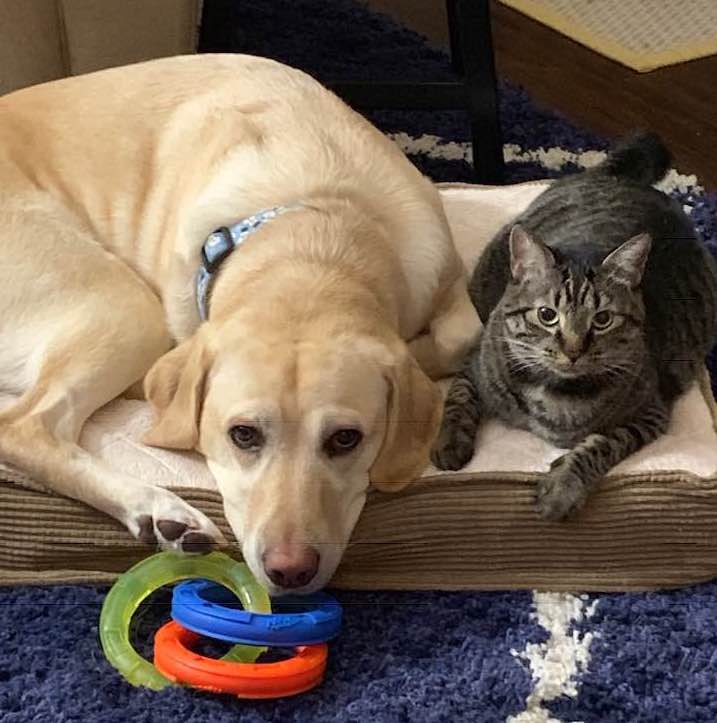

I’ve had cats most of my life and dogs most of my adult life, so when a friend with her first dog asked if I thought adopting a cat would be a good idea, I was intrigued. I know her dog, I know he likes my cat—he’s never barked at her or chased her. But I also know that’s just one cat’s worth of experience for that dog . . . and mine is a cat who’s very used to living with dogs.
I asked cat and dog owners, dog professionals, and veterinarians for their advice on this situation:
Single-dog household, dog seems to like cats, dog is currently home alone weekdays while the human works (a dog walker takes him out) and he’s bored (not destructive). The human has had cats in the past; the dog is the human’s first dog.
Would you advise adopting a feline? What age of cat might adjust most readily and be easiest to care for—kitten, adult, senior? How would you recommend that a cat be introduced to the dog? What would you suggest to help the cat get used to the new household?
Cat and Dog Owners
Cheri A. Moore Your question brought back memories. Many years ago we had an adult cat who was the only four-legged child in the house. My husband and I decided, that Christmas, to yield to our children’s pleading for a dog, and on Christmas morning, Santa brought a tiny Shih Tzu puppy so small he fit in my hand. Our cat took one look at that puppy, hissed, and ran. While they never fought, they never spent time in the same room, either. Time passed and tragically the Shih Tzu died. Six months later, we brought home a rescue dog, a full-grown Springer Spaniel/Red Heeler mix. Our cat took one look at this huge animal, swatted her on the nose . . . and they were fast friends for life!
Harald Groenen When we brought a cat home, we spent a few days keeping them in separate rooms. Then family members would carry the cat into the room and keep it near them on a piece of furniture. Eventually the dog and the cat became accustomed to each other, and began just going about their business in peace.
Katt Patt Make sure your dog listens when you say to leave it alone. Practice outside on a walk or dog park. We brought a Shar Pei into our home with cats and taught her to leave inside cats alone, but allowed outside cats to be chased. (The dog was not aggressive, but loved to chase!) We never forced the dog to be around the cat, and always had a [safe] place higher up where the cat could go.
Trudy Meakin Rogers I am currently a foster for SCRAPS (Spokane County Animal Control). In the last year, I have had over 35 kittens/cats. I have a purebred Border Collie and a terrier mix. Here is my experience:
I totally vote kitten. 95% of my kittens have been found sleeping with one of our dogs within two days. They bond quickly. They haven’t formed an opinion that they shouldn’t like them. Once my adult fosters are healthy, they have had no problem becoming part of the dog family.
Note: Our Border Collie herds every cat in our home. They quickly figure out that he is their friend and protector.

Photo by Janice Langbehn — Service Dog Lexi and cat Smokey
Veterinarians
Kelly Byam DVM I’ve never had just big dogs and a cat (not that it’s impossible), but if there was an altercation, I’d want to make sure the cat survived. Escape routes are essential. Dogs and cats can coexist, but it’s highly unlikely they’ll be besties. They are not natural companions. I just can’t recommend a cat as company, but they can always try fostering a cat or kitten until they find one that is compatible [with the dog].
Lori Leah Monet DVM Unless you have total control over your dog and it’s trained to the max . . . DON’T! I had to watch [a cat] die a terrible death yesterday—and it was the second cat in the house the dog had killed in a month. No, no, no.
Ruth L. Heller DVM I’ve never had trouble introducing kittens or adult cats to my dogs. But then, my dogs have always had cats around. My youngest cat and youngest dog adore each other, actually.
It’s very dependent on both the dog and the cat. It will come down to personality and training, but can certainly be successfully done. Careful introduction and plenty of ways for the cat to get away and be safe, including vertical space, are a must for it to work. Also, Adaptil and Feliway to reduce stress for both animals.
Dog Trainers
Ann Bemrose If the dog has liked cats previously, this shouldn’t be too difficult. Always make sure that the cat has plenty of options to get away to places the dog can’t reach—furniture, bookcases, and the like make a big difference. During the day, when you’re not at home, confine the cat to one room without the dog, just for safety’s sake, until you know that the two are able to be alone together.
Christine Hale Vertucci I currently have one 22-year-old female cat; we had a second cat that died about five years ago at age 19. We’ve owned three dogs during her lifetime and fostered several others, as well as a few other cats and kittens. During these years, we’ve lived in a two-bedroom condo, a townhouse, and finally a single-family home.
I would either look for a kitten or an adult cat that previously lived with dogs. I’d give the cat a quiet, safe space to acclimate to the new home—a spare bedroom or even a bathroom. I’d also make sure that the cat always has access to a safe space to escape the dog, with a barrier to keep the dog away from the cat’s food and litter box. I prefer pet gates with a small door that the dog can’t get through.
When the dog and cat are introduced, I’d have the dog on leash for safety. Work recalls [coming when called] away from the cat and “leave it.” Reward the dog for appropriate behavior around the cat.
Our cats have ended up loving the dogs and are really cozy with them. Our five-pound geriatric cat is practically inseparable from the 110-pound male Rottweiler, and she’s finally comfortable with the teenage female Rottweiler.
Flacortia Rosiea A young adult cat with previous experience with dogs would probably be the best bet. AO adapted really quickly to my four dogs and is Zeph’s bestie. If the cat has a safe dog-proof place and can come out in its own time, it will.
Anna Abney If the dog is proven cat-safe, it should be pretty easy. I recommend getting either a kitten or an adult cat who has lived peacefully with dogs. Look for a sociable, outgoing cat who is comfortable with a lot of handling and body contact.
Cats need escape routes like cat trees and rooms baby-gated off to keep the dog out. Cats can jump baby gates with no trouble so you don’t need to waste money on the ones with the little built-in door. I crate-train my cats just like my dogs. They eat in their specific crates and everything.
Colette Kase I’m currently in the opposite situation, bringing a rescue dog into a house with two cats. A ‘behaviorist’ assessed the dog as cat friendly. Not Even Close. We’re working on it. It will be a process of management, habituation, and socialization. Right now, they are kept separately but introduced in controlled ways daily, associating calmness and treats with hanging out.
Sandee Strobel Szabo I have two large dogs and have always had at least two large ones. I also have always had cats, since my hubby and I married, with our dogs. I volunteered with the Humane Society of Fairfax County and have introduced new cats to dogs and new dogs to cats. I have never separated them but I do advise others to do so. Even since we moved recently, we have taken into our house a neighbor’s cat who lives/d outside and now spends most of his time in our house. We have three other cats and two large dogs and all is well except for one of our cats, Baby Bella (aka Baby Brat), who is ticked at all the other cats in our house.
Cissy Stamm No cat currently with my dogs, but [I] have had them together for 15 years with no problems. Just make sure a new cat has a safe place to escape to, don’t force interaction, and leave them alone to figure it out.
Amy Fumetti-Levine Take the dog to the home of a friend who has a dog-friendly cat for a trial first. Keep the dog on leash for safety.
Jeanne Brennan I’ve always had multi-species homes, with dogs of all sizes and cats (and even pet rats when we were kids). In bringing a cat home to a house with a dog already in it, I would ask if the dog was responsive to verbal commands.
▪ Does he know “leave it,” and have a good recall?
▪ Is the dog crate trained, or can you use baby gates to cut down on the dog’s access to all of the house?
▪ Is the dog in the house and settled with the family most of the time the family is home?
To me, the more time dogs spend inside, with the family, the more responsive they are to family. These are the things I would consider about the dog’s personality.
For making the best pick with a cat? I would look for an adult, or something closer to full grown. I would look for a cat that seemed somewhat confident. Then any new cat that came home would be confined to one room to get used to smells, sounds, new surroundings, etc. Both animals will smell the new one there.
Eventually, I might lock the dog away in another room, or outside, and let the cat out to explore the house. I might put the cat in another room and let the dog in the cat’s room to sniff around. I might do some desensitization and counter-conditioning, giving the dog the best treats only when it can see the cat. I would advise people to go slow and not to make decisions based on their excitement for the pets to meet.
If barriers don’t create frustration, I might crate the dog—even cover the crate—and let the cat out to explore. I might deliver treats through the crate while the cat is out.
That said, I don’t actually do that much management. When I last fostered kittens, my dogs did meet them while the kittens were in their own room, in a huge Rottie-sized crate. Eventually the kittens had living room privileges, too, and sought out my old, friendly, Akita/German Shepherd mix to play with. I have also had numerous foster dogs come through, did a little early management, testing, crate training, and never had a problem. Part of this outcome has a lot to do with having cats that aren’t afraid to give a dog a lesson (even if unwarranted), and my ability to read and pick a dog. The general public does not have that ability, so I talk about training your dog, management, and slow introductions.
It should be stressed that sometimes, no matter what you try, some dogs will never be able to live with cats (or even smaller dogs). The important thing is to acknowledge that. Don’t be angry with the dog—that would be like being angry with me for not wanting to live with a spider terrarium in my house—and don’t try to force your will . . . because then every breathing creature in the house is stressed. (This last part is also something the general public isn’t good at.)
Introducing Dogs to Cats from American Humane



